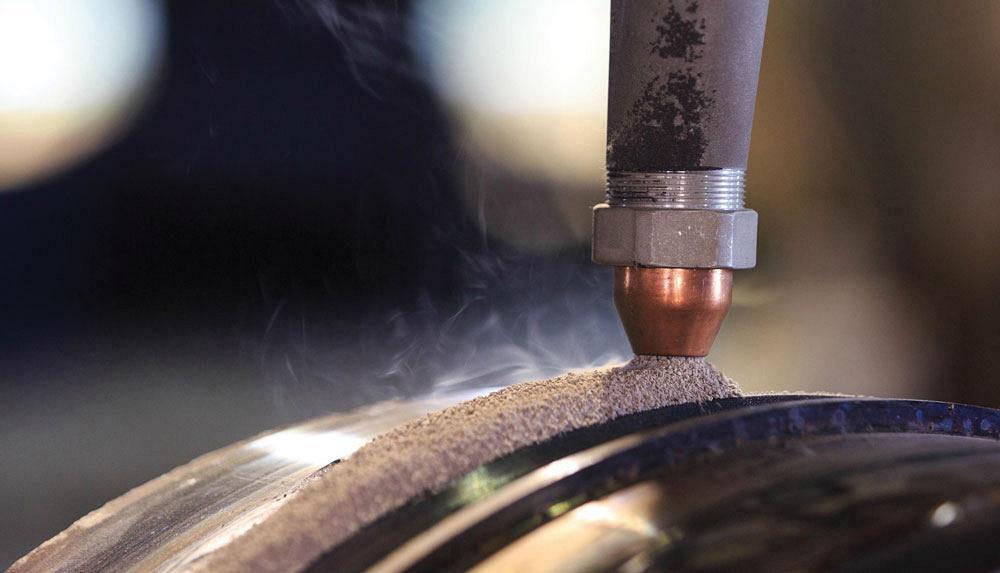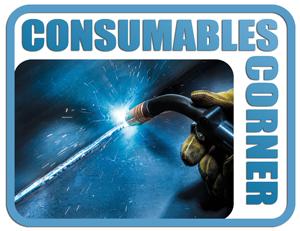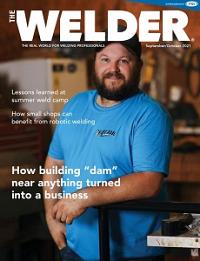Technical Liaison Manager
- FMA
- The Fabricator
- FABTECH
- Canadian Metalworking
Categories
- Additive Manufacturing
- Aluminum Welding
- Arc Welding
- Assembly and Joining
- Automation and Robotics
- Bending and Forming
- Consumables
- Cutting and Weld Prep
- Electric Vehicles
- En Español
- Finishing
- Hydroforming
- Laser Cutting
- Laser Welding
- Machining
- Manufacturing Software
- Materials Handling
- Metals/Materials
- Oxyfuel Cutting
- Plasma Cutting
- Power Tools
- Punching and Other Holemaking
- Roll Forming
- Safety
- Sawing
- Shearing
- Shop Management
- Testing and Measuring
- Tube and Pipe Fabrication
- Tube and Pipe Production
- Waterjet Cutting
Industry Directory
Webcasts
Podcasts
FAB 40
Advertise
Subscribe
Account Login
Search
Consumables Corner: Why defects happen with one-sided submerged arc welding
- By David Meyer and Rob Koltz
- November 3, 2021
- Article
- Consumables
Q: We are a structural steel shop that fabricates beams of various shapes and sizes. We often splice together plates for box beams or webs on I-beams by using a one-sided submerged arc welding process. Lately we have seen more weld issues such as lack of penetration or poor bead shape on the back-side weld. We recently changed our filler metal supplier and have a newer operator on the machine. Do you have any suggestions to fix this?
A: One-sided submerged arc welding (SAW-OSW) is a unique process that produces a high-quality weld deposit that appears to be welded from both sides while being welded only from the top side. This process has many variables that must be controlled very closely to produce repeatable, quality welds.
Let's start with the basic variables for SAW. Wire and flux, volts, amps, contact-tip-to-work distance (CTTWD), travel speed, torch travel angle, joint type and uniformity, and electrode spacing if you are using a tandem process can greatly affect weld performance and quality.
For OSW applications, additional variables include backing flux tray dimensions, joint gap consistency, type of backing flux (acidic, neutral, or basic), backing flux depth consistency, and plate clamping consistency (magnetic or mechanical).
The two issues you have experienced—lack of penetration and inconsistent backing weld appearance—are probably the two most common problems with SAW-OSW. Sometimes they can be resolved by adjusting one variable, but many times it requires an adjustment to a combination of several variables.
You stated that you changed filler metal supplier, and we’ll assume that means your flux manufacturer changed too. If so, make sure the wire, and more important the flux, is the same classification and type. In many OSW applications, two different fluxes are used, so make sure they are both correct for this process. Backing flux plays a huge role in backing weld consistency.
As with any weld manufacturing process, you should have proven welding procedure specifications (WPS). Double-check to make sure your operator is following the WPS and provide additional training so they understand what the variables are and how they affect weld performance and weld bead quality.
Whether you're welding with a single wire or a tandem configuration, the lead wire should be run on direct-current electrode-positive with constant-current arc control. This produces the best penetration of all polarities. Make sure CTTWD is correct and that the distance is roughly eight times the wire diameter and measured from the bottom of the weld joint.
Travel speed can affect penetration in two ways. First, weld penetration depends on heat input. High heat input should produce deeper penetration, but there is a limit, which leads us to the second factor. If travel speed is too slow, the weld puddle can advance in front of the welding arc, which acts like an insulator and reduces the arc's ability to penetrate deep into the joint.
Last, make sure the backing flux tray is in good condition and has the appropriate dimensions for the material thickness you are welding. The base material needs to have good contact with the top legs of the channel, which produces a dam that supports the backing flux. If the plates are not making good contact with the copper flux tray, the molten weld metal can eject out the side from the pressure. Also, be sure the backing flux is not disturbed while moving the plates into position for welding. These are all things that can affect back bead profile.
About the Authors


Rob Koltz
Application Engineer
411 S. Ebenezer Rd.
Florence, 29501
636-485-2253
About the Publication
Related Companies
subscribe now

The Welder, formerly known as Practical Welding Today, is a showcase of the real people who make the products we use and work with every day. This magazine has served the welding community in North America well for more than 20 years.
start your free subscription- Stay connected from anywhere

Easily access valuable industry resources now with full access to the digital edition of The Fabricator.

Easily access valuable industry resources now with full access to the digital edition of The Welder.

Easily access valuable industry resources now with full access to the digital edition of The Tube and Pipe Journal.
- Podcasting
- Podcast:
- The Fabricator Podcast
- Published:
- 04/16/2024
- Running Time:
- 63:29
In this episode of The Fabricator Podcast, Caleb Chamberlain, co-founder and CEO of OSH Cut, discusses his company’s...
- Trending Articles
Sheffield Forgemasters makes global leap in welding technology

Welding student from Utah to represent the U.S. at WorldSkills 2024

Lincoln Electric announces executive appointments

Engine-driven welding machines include integrated air compressors

ESAB unveils Texas facility renovation

- Industry Events
16th Annual Safety Conference
- April 30 - May 1, 2024
- Elgin,
Pipe and Tube Conference
- May 21 - 22, 2024
- Omaha, NE
World-Class Roll Forming Workshop
- June 5 - 6, 2024
- Louisville, KY
Advanced Laser Application Workshop
- June 25 - 27, 2024
- Novi, MI




























